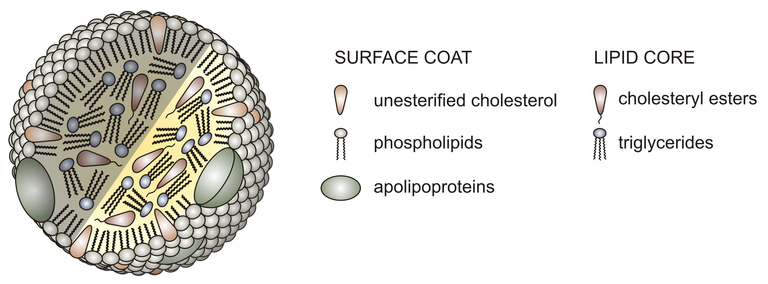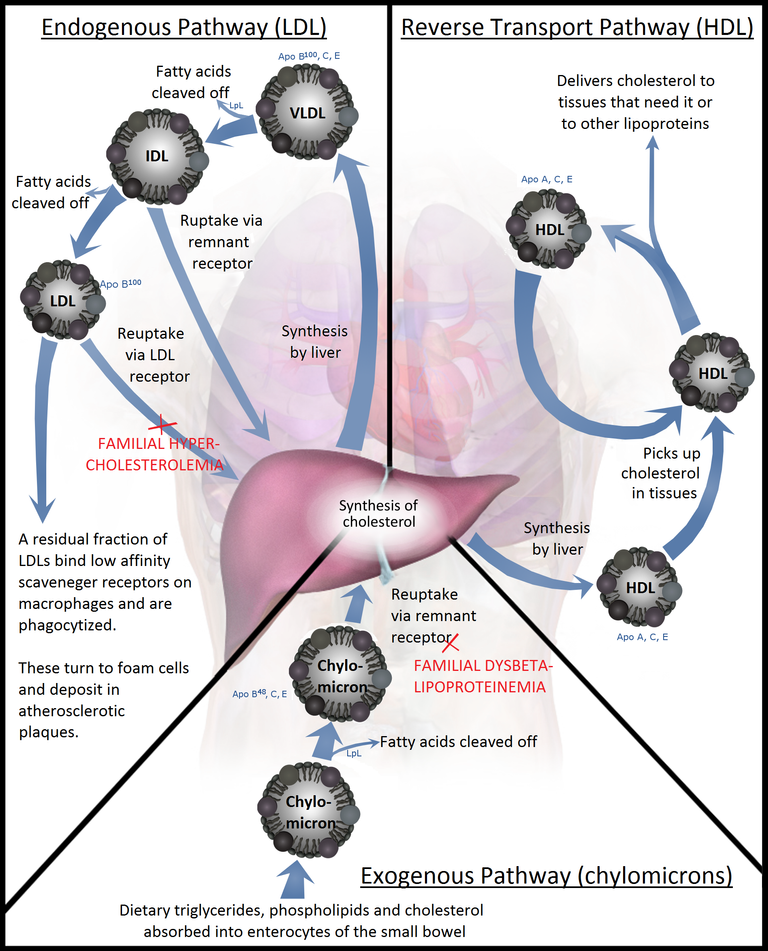Lipoprotein Metabolism (Explaining Chylomicrons, VLDL, HDL, IDL, and LDL)
It is no news that Lipids is synthesized in the body through biosynthetic pathways. Lipid acts as chemical messenger, store energy, and provides energy. Hyperlipidemia is a condition where there are high lipids in the blood. it is a genetic and acquired disorder where there is an elevated level of lipids in the human blood and body. It is a disorder that is very common and is a major factor responsible for cardiovascular diseases that could lead to death. You must have heard about high cholesterol levels causing numerous cardiovascular diseases, so I will be discussing how to address this issue and how to reduce lipids in the body, in this post..

Lipid-reducing medications are responsible for treating hyperlipidemia, and Hyperlipidemia patients have high low-density lipoprotein (LDL), high triglycerides levels, or low high-density lipoprotein (HDL) level. Let's quickly explain lipoprotein metabolism, to get a gasp of what's going on.
With lipoprotein metabolism, there are two different pathways, the Exogenous lipoprotein pathway and the Endogenous lipoprotein pathway. The exogenous pathway starts with the small intestine. If there are triglycerides, cholesterol, cholesterol esters and so on just digested, the stomach pushes the fat into the small intestine. It is important to know that chemoreceptors are found in the mucosa picking up fat signals, and fat concentration to stimulate special enteroendocrine cells. In the small intestine, the hepatopancreatic ampulla connects to the main pancreatic duct, the bile duct, and the gallbladder. The Cholecystokinin stimulates, the smooth muscle to contract and expel bile into the cystic duct. Bile is made up of cholesterol, phospholipids, water, electrolytes, Bilirubin (responsible for breaking down heme in haemoglobin, and giving pigment to faeces), and bile salts (made up of cholic acid, and deoxycholic acid).,. BIle Salt is the major component that emulsifies fat. Bile Salts interact with lipids and water. There is a hydrophobic portion of the bile that interacts with the fat, while the hydrophilic portion deals with the water portion of the lipid. In the small intestine, the triglycerides and the cholesterol (fat globule) pushed out of the stomach into it. Bile is then released into the small intestine, where the bile salt, cyclic acid, and deoxycholic acid binds with the fat globule, where it is seperated by the bile salt into fatty droplets. The pancrease also secreate the pancreatic lipase enzyme into the small intestine where it binds with co-lipase and starts engulfing the triglycerides, breaking the triglycerides into monoacylglycerides and free fatty acid. Cholesterol and vitamin A, D, E, and K also joins the monoglyceride and fatty acid, known as a micelle which moves into the enterocytes then into the smooth endoplasmic reticulum where it becomes triglyceride, forming a cycle. It moves to the rough endoplasmic reticulum where it synthesizes APO protein B-48 with the triglyceride to become a lipoprotein called chylomicron which is pushed into the circulation. ,,,.

After being absorbed into the intestinal wall, the Chylomicron goes into a lymphatic capillary in the intestine known as the lacteal to become lymphatic vessels. The Chylomicron passes through the thoracic duct to get into the bloodstream.. In the blood, the chylomicron (including APO protein B-48, tryglycerides, cholesterol, and cholesterol esters) is attached to High density lipoprotein (HDL), which donates Apolopoprotein E (Apo-E), and Apolopoprotein C2 (Apo-C2) to the chylomicron. APO-E can bind with low density lipoprotein (LDL), (APO C2 is responsible for activating an emzyme in the capillary endothelium). In the Capillary, the Chylomicron moves to the Liporpotein Lipase to break lipids such as triglycerides, releasing free fatty acids, and glycerol. ,.
The free fatty acid goes to the adipocyte and the the skeletal muscle. In the skeletal and cardiac muscle, the free fatty acids are broken down by beta-oxidation into acrtyl-co-a. Acetyl coa then krebs cycle, followed by electron transport chain, after which energy (ATP) is produced. In the Adipocyte, Free Fatty Acid (FFA) becomes triglyceride.,,,.
The glycerol from the chylomicron moves with triglyceride, phospholipid, Apolipoprotein B48 molecule, and Apolipoprotein E in the bloodstream, to reach LDL receptors and LDL receptor related protein in the liver, where it is broken down to protein, the trygluceride is stored, the cholesterol can be converted into Bile salt, it can be stored as Cholesterol ester through lecithin:cholesterol acyltransferase (LCAT), or incorpurated into the cell membrane. In the liver, the Apo B100 protein combines tryglyceride from the chylomicron also from glocose to cholesterol, to become very low-density lipoprotein (VLDL) molecule, where it gets pushed into the bloodstream. In the bloodstream, HDL releases Apo E and Apo C2 protein to the VLDL. The VLDL with the APO E and APO C2 stimulates the Lipoprotein Lipase (LPL), thereby breaking down the tryglyceride into glycerol which can go back into the liver, also it can break it down into free fatty acids that goes into the skeletal muscles and adipose tissue where they begin the process of the making ATP in the muscle, and for storage of tryglycerides in the adipocyte. The APO C2 in the VLDL is returned back to the HDL.,,, .
The VLDL remnant also knwon as Intermidiate density Lipoprotein which composed of trygluceride, cholesterol, and cholesterol esters, and associated with APO B100 and APO E, can move to the liver where it is taken up and digested in the way VLDL was digested to give out ATP, or it can also go to the adrenal cortex where the cholesterol is utilized in creating corticoids in the cortex. The IDL can also react with Hepatic Triglyceride lipase in the liver or cortex to give free fatty acid, decreasing the triglyceride in the IDL, transfering APO E to the HDL, and allowing the IDL to become LDL.,,.
The LDL can move to the gonads, since the gonads have LDL receptors, transfering cholesterol to the Gonads. This causes hormone progesterone and estrogen to be produced in females, while Testosteron will be produced in males. While most of the LDL goes back to the Liver where it is broken down, as well as it is transported to other pheripheral tissue (Macrophages, and Adrenal Cortex) where it can be used.,.
If LDL stays long in the blood, it can be detrimental. When it accumulates for a long time, it can undergo oxidation, which reacts with the LDL where it becomes Oxidative low-density lipoprotein (OLDL) where it causes macrophages to begin to engulf the OLDL, and the macrophages become Foam cells, leading to atherosclerosis.. When Glucose reacts with the LDL, it would become GLDL which can also cause atherosclerosis. .
Image Reference
Image 1 || Wikimedia Commons || Structure of a Lipoprotein
Thanks for this wonderful lecture on lipoprotein metabolism.i love it and would love to know more about it.
Nice showing about that! it is a nice biochemistry lesson

!1UP
You have received a 1UP from @gwajnberg!
@stem-curator, @neoxag-curator
And they will bring !PIZZA 🍕.
Learn more about our delegation service to earn daily rewards. Join the Cartel on Discord.
I gifted $PIZZA slices here:
@curation-cartel(7/20) tipped @eni-ola (x1)
Join us in Discord!
Thanks for your contribution to the STEMsocial community. Feel free to join us on discord to get to know the rest of us!
Please consider delegating to the @stemsocial account (85% of the curation rewards are returned).
Thanks for including @stemsocial as a beneficiary, which gives you stronger support.